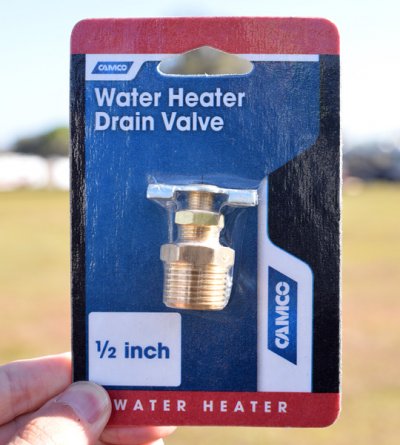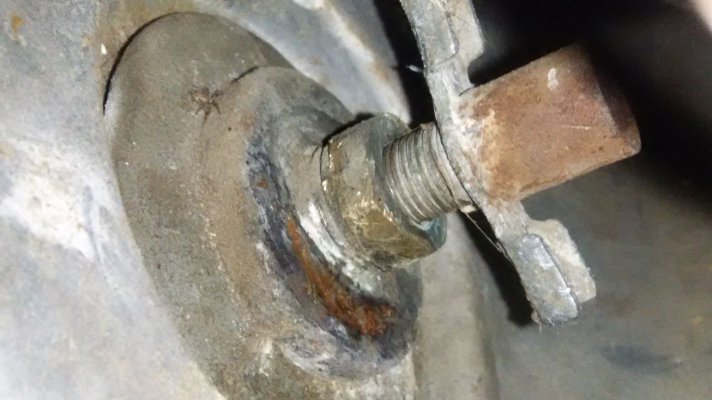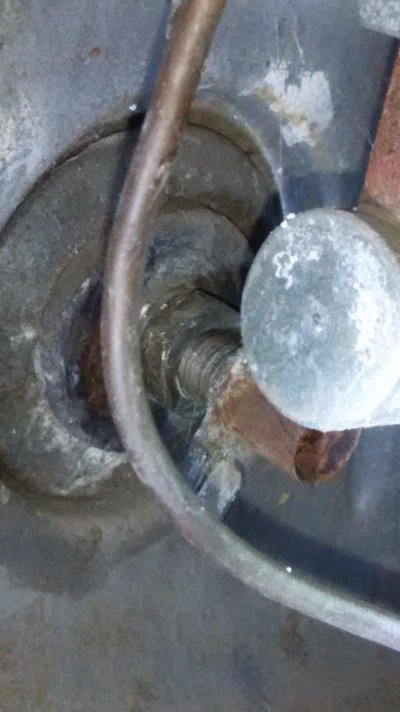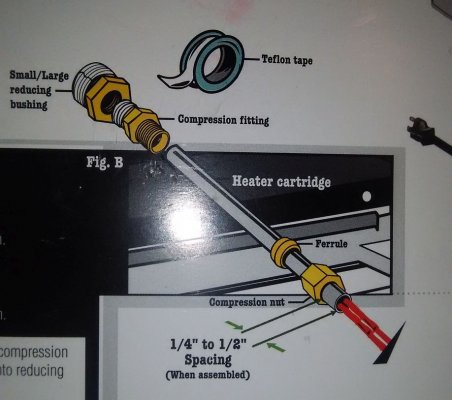I'm trying to convert my propane water heater into an electric one with this kit I bought, but it looks like I'm supposed to install one of these larger ones. I took a picture of my drain plug. I don't even know what i'm looking at. It seems it's only the small part. Am I unable to install the kit with this type of drain plug?
You are using an out of date browser. It may not display this or other websites correctly.
You should upgrade or use an alternative browser.
You should upgrade or use an alternative browser.
Electric Water Heater Conversion
- Thread starter salve
- Start date
The friendliest place on the web for anyone with an RV or an interest in RVing!
If you have answers, please help by responding to the unanswered posts.
If you have answers, please help by responding to the unanswered posts.
What make and model of water heater do you have? Personally, I wouldn't use that type of drain plug in either a Suburban or Atwood. The Atwood should have a plastic/poly drain plug, and a Suburban should have a a drain plug with an anode built on it.
John From Detroit
Well-known member
The drain plug is a standard 1/2 inch IPT the brass radiator drain cock was screwed in and that assembly includes an adapter. YOu will need to remove all the brass, both the radiator drain cock (Which by the way I do not recommend Using) and the brass reducer that it screws into.
Rene T
Site Team
This is what you will need. I don't know why you're showing a picture of a new drain plug. You won't be able to have the hot rod and the drain plug at the same time.
https://www.amazon.com/Diamond-Group-HR6-Universal-Hott/dp/B002SSIBSA
https://www.amazon.com/Diamond-Group-HR6-Universal-Hott/dp/B002SSIBSA
I don't have any idea what type of water heater it is. I don't know how to go about finding out.
There's a lot I'm not understanding about the responses here. I think I didn't make my question clear. I bought this already:
https://www.amazon.com/gp/product/B0024ECCJW/ref=oh_aui_detailpage_o00_s00?ie=UTF8&psc=1
This kit I bought requires that I screw in something that's too large for what I'm seeing in my own drain plug.
What is "temperature recovery"?
There's a lot I'm not understanding about the responses here. I think I didn't make my question clear. I bought this already:
https://www.amazon.com/gp/product/B0024ECCJW/ref=oh_aui_detailpage_o00_s00?ie=UTF8&psc=1
This kit I bought requires that I screw in something that's too large for what I'm seeing in my own drain plug.
What is "temperature recovery"?
Attachments
Lou Schneider
Site Team
- Joined
- Mar 14, 2005
- Posts
- 13,238
First of all, Welcome to The RV Forum!
Temperature recovery is how long it takes for the water to get hot again after you've used all of the hot water in the tank.
The gas flame produces about 12,000 BTUs of heat. The factory installed heating element in a gas/electric water heater uses 1500 watts to produce about 5100 BTUs of heat, so a factory installed electric element will take 2 1/2 times longer to reheat a tank of water compared to using the gas flame.
The element you're installing uses 425 watts to produce 1450 BTUs of heat, so it will take 8 times longer than the gas flame to heat a tank of water.
I suggest abandoning this project. It looks like your existing drain plug is rusted in place (where the large nut meets the tank), and if you have to crank on the nut to get it to break free you risk tearing out the tank socket, which will ruin the water heater.
Why do you want to convert the water heater to electric operation?
Temperature recovery is how long it takes for the water to get hot again after you've used all of the hot water in the tank.
The gas flame produces about 12,000 BTUs of heat. The factory installed heating element in a gas/electric water heater uses 1500 watts to produce about 5100 BTUs of heat, so a factory installed electric element will take 2 1/2 times longer to reheat a tank of water compared to using the gas flame.
The element you're installing uses 425 watts to produce 1450 BTUs of heat, so it will take 8 times longer than the gas flame to heat a tank of water.
I suggest abandoning this project. It looks like your existing drain plug is rusted in place (where the large nut meets the tank), and if you have to crank on the nut to get it to break free you risk tearing out the tank socket, which will ruin the water heater.
Why do you want to convert the water heater to electric operation?
I agree that pulling that corroded petcock type drain plug looks scary, you could easily damage the tank. If you intend to proceed I would try to gently chip away some of the corrosion with an awl or small screw driver. Then I would spray it with some penetrating oil like liquid wrench for a couple of days and tap the plug base with a hammer and a punch each time you put more penetrating oil on the plug. When it is time to put a wrench on it be careful and don't overdue the pressure on the wrench. If it still won't come out try tightening it A LITTLE and repeat the penetrating oil. I have had good luck with penetrating oil and tapping with hammer and punch but patience is the best tool.
That said, our latest trailer has a propane only water heater. The one before had gas/electric. I added a Hott Rod electric kit to the water heater 5 years ago and we love it. It saves us a bunch of propane and gives us longer showers and quicker recovery for each or us getting a shower one after the other when using gas and electric together.
That said, our latest trailer has a propane only water heater. The one before had gas/electric. I added a Hott Rod electric kit to the water heater 5 years ago and we love it. It saves us a bunch of propane and gives us longer showers and quicker recovery for each or us getting a shower one after the other when using gas and electric together.
Gary RV_Wizard
Site Team
Despite the difference in btus vs gas, the electric heat elements actually work reasonably well. Slower to heat a cold tank from scratch, but not so noticeable when re-heating. Besides, you can still use the gas flame, either at the same time or instead of the electric.
Agree with the others that removing that old and corroded plug is going to take extreme care and techniques that may be beyond salve's apparently limited plumbing experience & skills. Should get some more skilled help, whether a friend or professional.
Agree with the others that removing that old and corroded plug is going to take extreme care and techniques that may be beyond salve's apparently limited plumbing experience & skills. Should get some more skilled help, whether a friend or professional.
The nut that you see in the picture of my water heater tank is small like the "compression fitting" in the diagram I uploaded. But it says I need to put in that other larger nut, the "reducing bushing". My question was basically what to do if the larger one doesn't fit. Am I allowed to just use the smaller one? That only now occurred to me but before I was just trying to follow the instructions exactly.
And also if I do in fact break the water heater tank by trying to get that drain plug out, is there a crude but simple way to simply seal it back up permanently?
And also if I do in fact break the water heater tank by trying to get that drain plug out, is there a crude but simple way to simply seal it back up permanently?
Rene T
Site Team
salve said:The nut that you see in the picture of my water heater tank is small like the "compression fitting" in the diagram I uploaded. But it says I need to put in that other larger nut, the "reducing bushing". My question was basically what to do if the larger one doesn't fit. Am I allowed to just use the smaller one? That only now occurred to me but before I was just trying to follow the instructions exactly.
And also if I do in fact break the water heater tank by trying to get that drain plug out, is there a crude but simple way to simply seal it back up permanently?
I don't see much corrosion others have talked about. The fitting which needs to be removed is made out of brass looking at the picture. I would recommend you use a socket to back it out not just a open ended wrench. You may have to break of the petcock in order to get the socket on the fitting. I also recommend soaking in penetrating oil for a few days.
What you do need to know is whether the heater is made by Atwood or Suburban. There should be a label on the right side of the heater on the outside. If it's a Suburban, they use what is called a anode derain plug. The drain plug has a piece of zinc attached to the drain plug. The chemicals in the water attack the anode instead of the heater tank. I don't know what people do as far a using a Hot Rod on a Suburban water heater. On a Atwood, it's not a problem. Just remove the 1/2" IPS pipe fitting on install the Hot Rod fitting. Then just insert the element and tighten the compression fitting to stop any leakage.
Alfa38User
Well-known member
- Joined
- Oct 4, 2007
- Posts
- 6,678
That large drain plug says it is a Suburban heater.
Simply take the petcock out first while holding the adapter with a large wrench so it won't turn. The original drain plug (with the anode) on that heater needs a 1 1/16" socket or wrench, so I expect the adapter to be the same or very close. I recommend a 6 point socket as they will not skip and damage the piece and a power bar on a 4" extension, used gently.
What do people do?? They simply toss the plug with the anode, just as the original owner of this one did. Petcocks simplify the draining process but.... all the crap accumulating in the bottom of the heater will not likely drain properly.
If you break it, the only simple way to fix it is to buy a new water heater.
Simply take the petcock out first while holding the adapter with a large wrench so it won't turn. The original drain plug (with the anode) on that heater needs a 1 1/16" socket or wrench, so I expect the adapter to be the same or very close. I recommend a 6 point socket as they will not skip and damage the piece and a power bar on a 4" extension, used gently.
What do people do?? They simply toss the plug with the anode, just as the original owner of this one did. Petcocks simplify the draining process but.... all the crap accumulating in the bottom of the heater will not likely drain properly.
If you break it, the only simple way to fix it is to buy a new water heater.
Rene T
Site Team
Alfa38User said:That large drain plug says it is a Suburban heater.
What do people do?? They simply toss the plug with the anode, just as the original owner of this one did.
I wonder how much the lifespan of the heater tank is reduced by doing away with the anode. I've seen what it does to the anodes sometimes just after a year or so. I know that the tank won't deteriorate as fast as the anode but is it worth it just to have the electric element option.
i wanted the electric conversion so that i don't have to go outside every time i want to take a shower; i can just flip a switch. i hate going outside.
is there anyway you can leave the pilot light and the propane on all the time or something? or operate it from inside the trailer? are you allowed to leave the propane in general switched on all the time?
is there anyway you can leave the pilot light and the propane on all the time or something? or operate it from inside the trailer? are you allowed to leave the propane in general switched on all the time?
Rene T
Site Team
Leave it on all the time. No problem.
My Motorhome came from the factory with a gas water heater but there is also an electric rod that plugs into the 120 VAC outlet inside near the water heater.
It simply screws into the bottom drain plug. I remove it approx. once a year, wire brush the corrosion and it's as good as new.
It's labeled 120 VAC 400 watts and heats up water fairly fast. The gas heater can be used at the same time to speed things up if needed.
They'll last forever if you maintain them. Just wire brush by hand or electric wheel once every year or two.
It simply screws into the bottom drain plug. I remove it approx. once a year, wire brush the corrosion and it's as good as new.
It's labeled 120 VAC 400 watts and heats up water fairly fast. The gas heater can be used at the same time to speed things up if needed.
They'll last forever if you maintain them. Just wire brush by hand or electric wheel once every year or two.
Gary RV_Wizard
Site Team
is there anyway you can leave the pilot light and the propane on all the time or something? or operate it from inside the trailer? are you allowed to leave the propane in general switched on all the time?
Sure, just leave the pilot on. It has a thermostat, just like the water heater at your home. It's a good idea to turn it off again before you travel again, but leave it on while parked at the campsite.
when you turn on the propane is there supposed to be a constant hissing, part of which seems to be coming out of the regulator vent, but not all? there's a constant noise. i put my finger over the vent and it is largely this. but it doesn't stop. what exactly is a vent for? shouldn't the propane just stop moving when there is nothing using it? like blocked, like when it's still in the container?
Latest posts
-
-
Help identifying Solar charging jacks on power station
- Latest: John From Detroit
-
-
-
-
-
-
-
-




